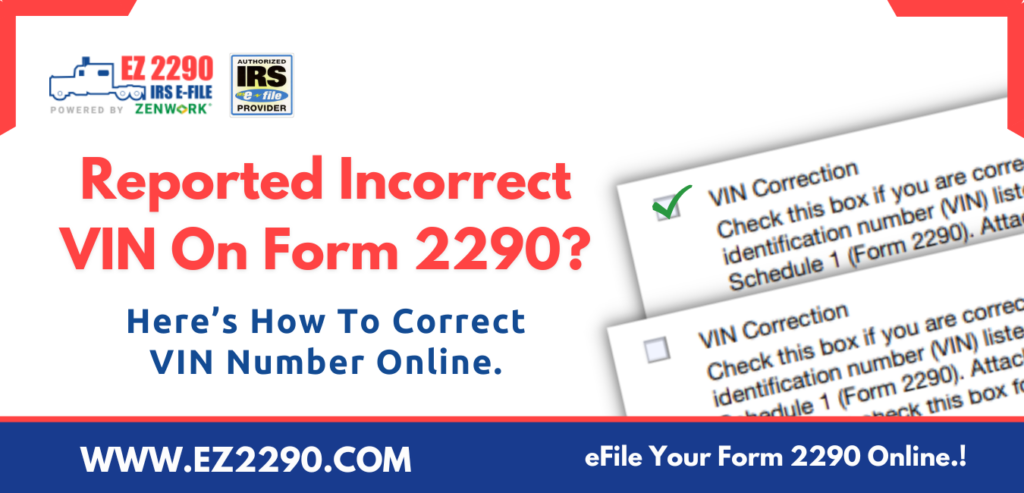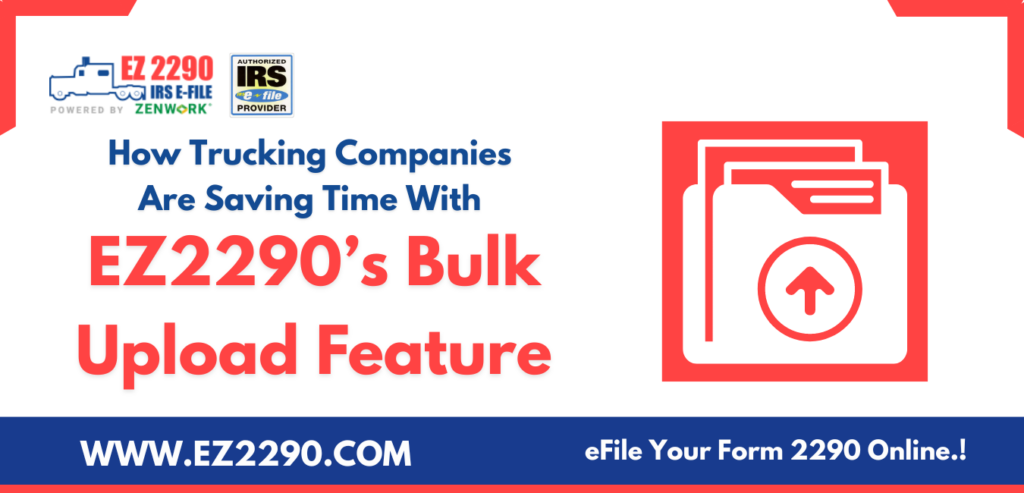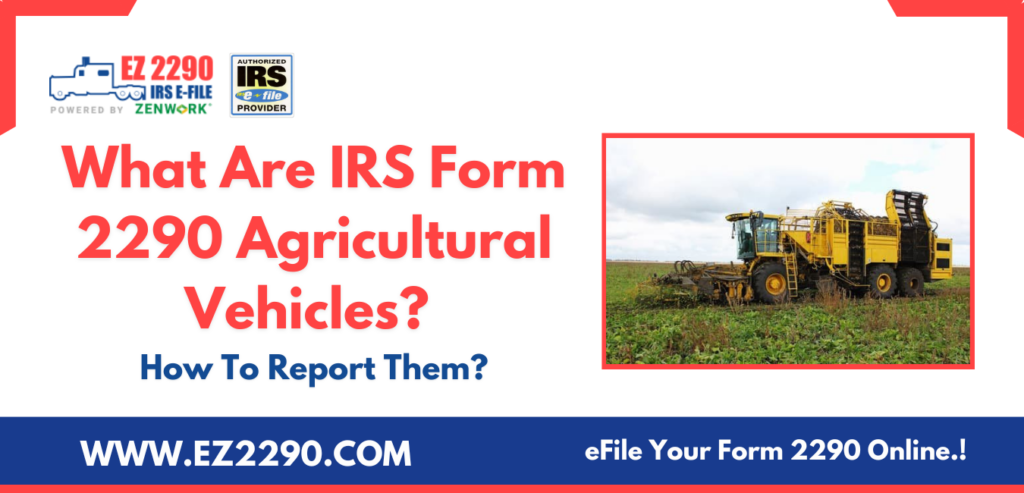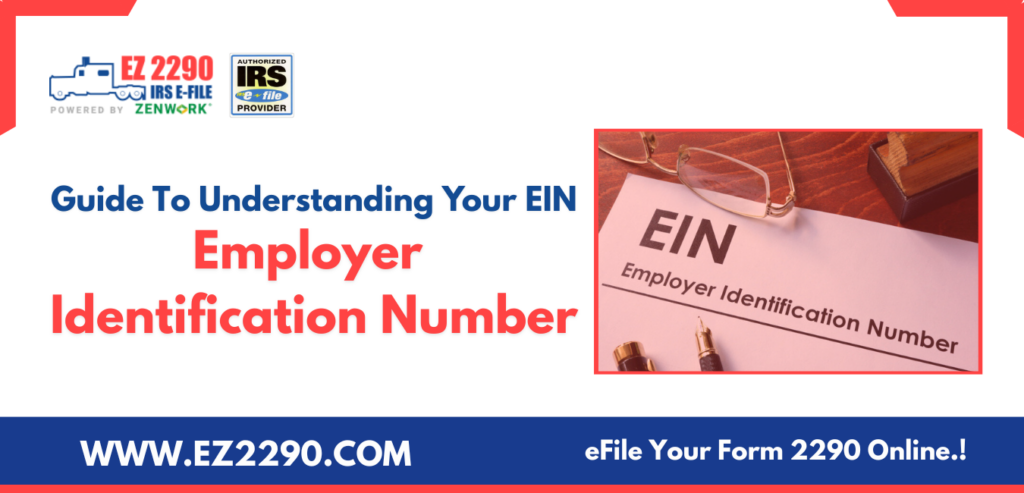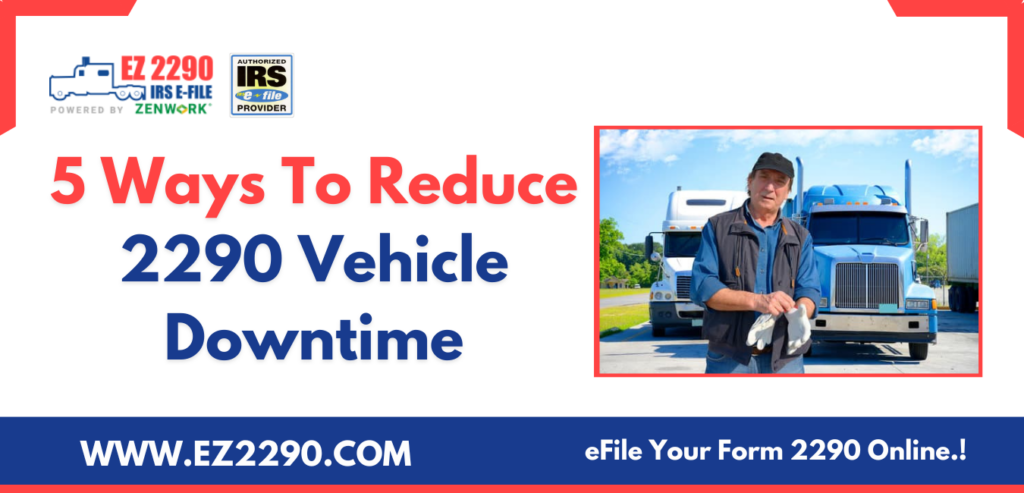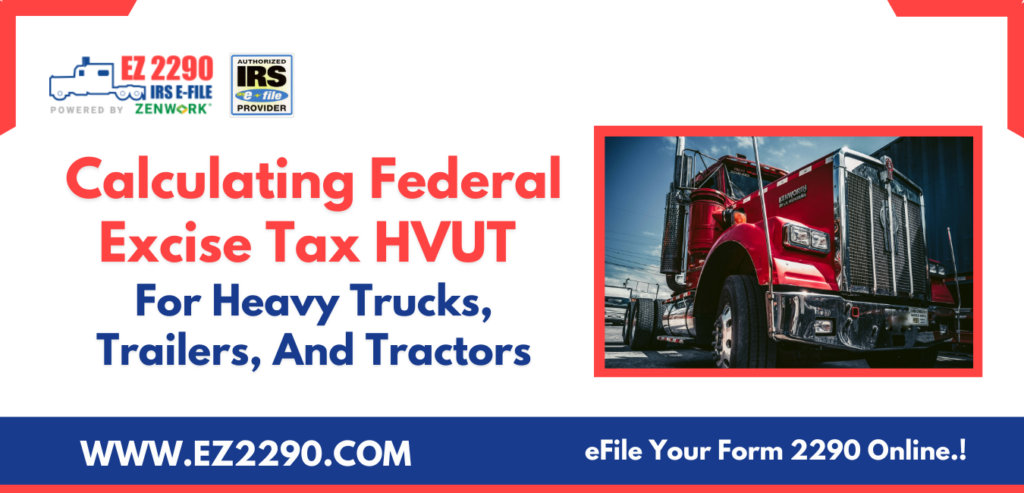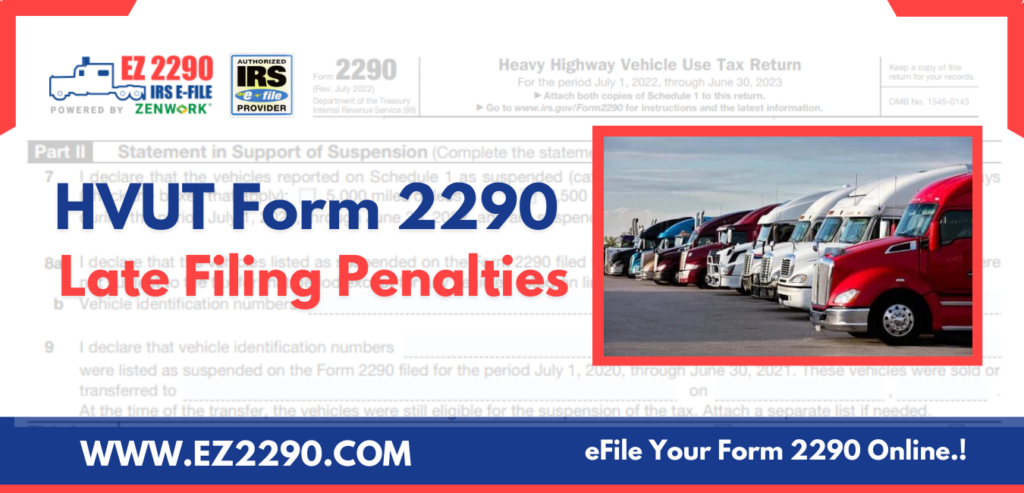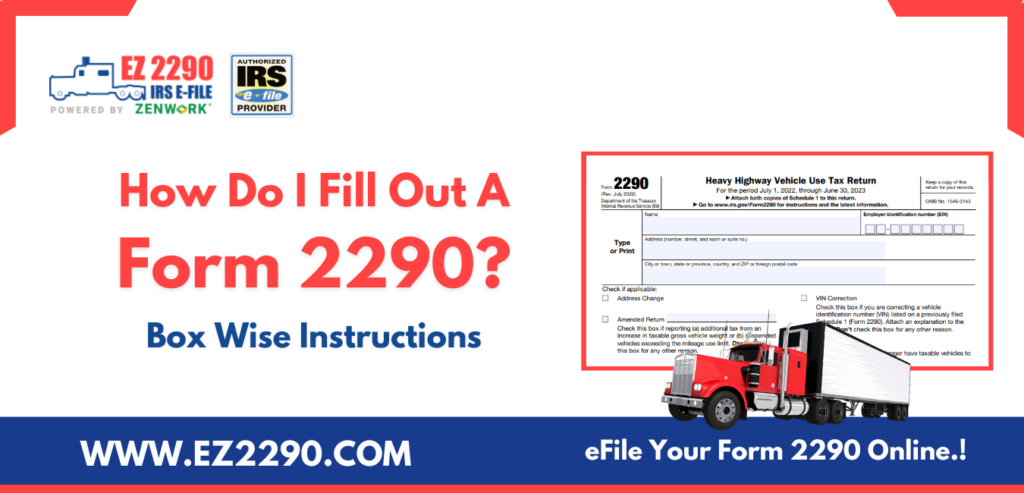
A simple guide to help you fill out HVUT Form 2290 online easily and quickly.
Here’s What You’ll Find In This Read
- Understanding HVUT Form 2290
- Before You Begin: Information You Need To Fill Out Form 2290
- IRS Form 2290: Box-Wise Instructions
- eFile HVUT Form 2290 Online Easily Using EZ2290
Understanding HVUT Form 2290
Heavy Highway Vehicle Usage Tax form or HVUT Form 2290 is an IRS tax information return.
Trucking companies, truck owners, owner-operators, and fleet companies prepare and file this federal excise form to report certain vehicle information and pay the HVUT due on the vehicles.
Vehicles weighing 55,000 pounds or more qualify for HVUT reporting.
Information pertaining to agricultural vehicles, non-agricultural vehicles, logging vehicles, non-logging vehicles, credit vehicles, and suspended vehicles, is typically reported on Form 2290.
The 2290 information reported on Form 2290 is used to assess HVUT tax on qualified vehicles.
Even if a vehicle has multiple owners, Form 2290 must be filed and the HVUT tax due on such a vehicle must be paid before the IRS 2290 due date.
Before You Begin: Information You Need To Complete Form 2290
Check if you have all the information needed to prepare and complete your 2290 HVUT filings.
- Legal name of the business or DBA (Doing Business As) name
- EIN (Employer Identification Number) or TIN (Taxpayer Identification Number)
- Business address
- Taxable gross weight of the vehicle
- Vehicle categories
- Vehicle identification number
- Month of first use
- Mileage use limit (miles utilized or exceeded or under-utilized by vehicles)
- Logging status of the vehicle
- Suspension status of the vehicle
- Total number of vehicles
This information, coupled with tax computation, completes your 2290 reporting regime.
You can do this easily by importing your bulk vehicle data to EZ2290. (More on this later)
IRS Form 2290: Box-Wise Instructions
Business Details
Legal name: Enter the legal name of the business in the first field of Form 2290.
EIN: Enter the employer identification number (EIN) or taxpayer identification number (TIN) in the “EIN” box located at the top of Page 1. You also need to enter the EIN in Schedule 1. Both EINs must be the same. If you don’t have an EIN, you can also report its equivalent, social security number (SSN). However, this number must correlate with your DOT/DMV records.
Business address: Enter the operational/official address of your business in this space. Include the door number, street name, county name, and other details per the USPS address records.
Filing options: If you’re filing a 2290 return for the first time or for the current filing period, you don’t have to select anything.
- However, if you’re amending previously filed reports, then you need to select “Amended Return”.
- If you want to correct a vehicle identification number (VIN) that was previously reported, then you need to select the “VIN Correction” filing option.
- You must only select “Final Return” as a filing option when you’re filing the 2290 return for the last time or if you have no taxable vehicles to report.
Page 2: Tax Computation
Note: The section following Business Details is ‘Part I’. However, we’ll be computing the tax in the ‘Tax Computation’ section for your understanding. Further, Part I mostly focuses on deriving the net tax amount after deductions (for which you’ll need to complete Tax Computation first).
Enter the number of vehicles you own in accordance with the logging status and tax period in Column 3.
If you own 3 logging vehicles and 6 non-logging vehicles, then enter this information in the relevant columns.
Non-logging vehicles go in the ‘Vehicles except logging*’ column or column 3(a).
Logging vehicles go in the ‘Logging vehicles*’ column or column 3(b).
If you have vehicles that are partially taxed over a period, then the amount of the tax must be reported in Column 2. Use columns 2(a) and 2(b) as necessary.
Column 4: Now, multiply Column 1 with Column 3. Here, you’re multiplying the number of vehicles with the associated tax rates (per the taxable gross weight of vehicles).
Enter the total number of vehicles (including logging and non-logging vehicles) in the ‘Totals’ row at the bottom of this section.
Calculate the Total by adding up all the values entered in each row of Column 4. This is the total tax.
This total amount must also be reported on Line 2 of Part 1.
Part I – Figuring the Tax
Line 1: Enter the date for the month of first use in this field. If you first started using the truck in, say, August 2022, then 202208 must be reported on Form 2290.
If you’re filing for a previous period, then you need to enter that month and year. You may need to pay a higher tax, depending on the additional proof or documentation you’re attaching with your filings.
If you’re filing for a used or newly purchased used vehicle (for which the tax for the current period has been paid by the seller), then the month following the month of purchase must be reported as the month of first use on Form 2290. In such a case, the seller should file a refund for the excess tax paid.
Line 2: The Total amount figured in Column 4 must be entered in this field.
Line 3: If the gross taxable weight of the vehicle has increased, then the additional tax paid must be reported in this field. This tax is added to the amount in Line 2.
Line 4: Add line 2 and line 3. You’re adding the tax you owe to the additional tax. This is your Total Tax.
Line 5: If you’ve claimed refund credits from the IRS for your HVUT vehicles, then the same refund credit must be reported here.
Line 6: Deduct the credit claims from your Total Tax, and you have the net tax or the tax you owe to the IRS.
Part II Statement In Support Of Suspension
This section is used for reporting tax suspension details of your vehicles.
If a vehicle has been suspended from HVUT tax, then the vehicle details, such as the vehicle identification number (VIN), mileage use limit, the period for which the vehicle remains suspended, and other details must be reported on Part II.
This is also where Third Party Designee’s details and consent must be provided.
If you’re a preparer, you need to furnish the necessary information in the “Paid Preparer Use” section.
Information such as the name of the preparer, signature, date, PTIN, Firm’s EIN, Firm’s name, and contact information must be furnished.
There is an additional consent form ‘Consent to Disclosure of Tax Information’ that must be signed and certified by the taxpayer after completing Form 2290 but before filing.
Schedule Of Heavy Highway Vehicles
This is probably the easiest part of your 2290 form completion process.
However, be careful.
This is also the step where most businesses fail to accurately report the vehicle identification numbers and depend on VIN Corrections to correct the incorrect VINs previously reported.
Details like the EIN, vehicle identification numbers, vehicle categories (as defined in ‘Tax Computation’ section), the month of first use, and business details are critical for this section.
Enter the 17-digit vehicle identification numbers in the boxes.
If you’re e-filing with a dynamic eFile provider like EZ2290, you can import your VINs and category information from your computer.
EZ2290 will dynamically populate the form with the appropriate data.
Part II: Summary Of Reported Vehicles
Report the total number of the reported vehicles and the tax-suspended vehicles in Line ‘a’ and Line ‘b’ respectively.
Line ‘b’ must be subtracted from Line ‘a’.
This gives us the total number of taxable vehicles.
eFile HVUT Form 2290 Online Easily Using EZ2290
2290 form completion is just one side of the coin.
Once you’re done completing the form, you’ll need a reliable and secure platform to e-file your 2290 returns.
Hundreds of thousands of trucking businesses are switching to electronic filing to avoid hefty paperwork, missed mailings, and inconsistencies in filings.
eFiling solutions from EZ2290 enable you to:
- eFile your 2290 forms securely with a 256-bit advanced encryption standard
- Keep a track of your IRS Form 2290 filings, previous HVUT filings, and other IRS communications in one place.
- File VIN Corrections for free
- Re-file rejected returns for free
- Manage bulk 2290 filings in one place seamlessly
What’s even better is that you can have EZ2290 prepare your 2290 returns on your behalf with our Managed Services, saving you time and effort. Check it out
Sign Up Now & eFile 2290 With EZ2290
Other Useful Reads From Ez2290 Blog
- Reported Incorrect VIN On Form 2290? Here’s How To Correct VIN Number Online
- Only A Few Days Left To eFile Your 2290 Forms. Are You Ready?
- How Trucking Companies Are Saving Time With EZ2290’s Bulk Upload
- What Are IRS Form 2290 Agricultural Vehicles? How To Report Them?
- Guide To Understanding Your EIN & Why You Must Have An EIN To File Form 2290?
